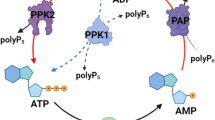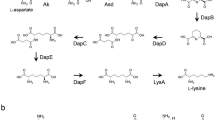Abstract
Streptomyces albulus PD-1 can co-produce antimicrobial homo-polymers poly(ε-lysine) (ε-PL) and poly(l-diaminopropionic acid) (PDAP). In this study, a novel feeding strategy of citric acid coupled with glucose-(NH4)2SO4 feeding was employed to S. albulus PD-1. When the pH of the culture broth dropped to 4.0, the feeding solution was added continuously to maintain the concentrations of glucose and citric acid at 10 and 4 g L−1, respectively. As a result, the final concentration of ε-PL increased from 21.7 to 29.7 g L−1 and the final concentration of PDAP decreased from 4.8 to 3.2 g L−1. Assays on intracellular nucleotide levels and key enzyme activities were performed to elucidate the underlying regulation mechanism. The addition of citric acid increased NADH/NAD+ ratio and decreased intracellular ATP level; meanwhile, the activities of pyruvate kinase, citrate synthase and isocitrate dehydrogenase decreased while aspartate aminotransferase activity increased. Therefore, we deduced that citric acid feeding resulted in metabolic flux redistribution at the node of phosphoenolpyruvate; the metabolic pathway from phosphoenolpyruvate directed into tricarboxylic acid cycle was weakened and thus PDAP production was inhibited. On the other hand, the metabolic pathway from phosphoenolpyruvate directed into oxaloacetate and l-aspartate was enhanced, thereby improving ε-PL production. This fermentation strategy may be potentially useful in ε-PL production because it can effectively inhibit the formation of by-products, such as PDAP.





Similar content being viewed by others
References
Nishikawa M, Ogawa K (2002) Distribution of microbes producing antimicrobial ε-poly-l-lysine polymers in soil microflora determined by a novel method. Appl Environ Microbiol 68:3575–3581
Shima S, Matsuoka H, Sakai H (1982) Inactivation of bacteriophages by ε-poly-l-lysine produced by Streptomyces. Agric Biol Chem 46:1917–1919
Shima S, Matsuoka H, Iwamoto T, Sakai H (1984) Antimicrobial action of ε-poly-l-lysine. J Antibiot 37:1449–1455
Shih IL, Shen MH, Van YT (2006) Microbial synthesis of poly(epsilon-lysine) and its various applications. Bioresour Technol 97:1148–1159
Cai L, Tabata H, Kawai T (2002) Probing electrical properties of oriented DNA by conducting atomic force microscopy. Nanotechnology 12:211–216
Laurinavicius V, Kurtinaitiene B, Liauksminas V, Ramanavicius A, Meskys R, Rudomanskis R, Skotheim T, Boguslavsky L (1999) Oxygen insensitive glucose biosensor based on PQQ-dependent glucose dehydrogenase. Anal Lett 32:299–316
Bankar SB, Singhal RS (2010) Optimization of poly-ε-lysine production by Streptomyces noursei NRRL 5126. Bioresour Technol 101:8370–8375
Hiraki J, Masakazu H, Hiroshi M, Yoshikazu I (1998) Improved poly-l-lysine production of an S-(2-aminoethyl)-l-cysteine resistane mutant of Streptomyces albulus. Seibutsu Kogaku Kaishi 76:487–493
Kahar P, Iwata T, Hiraki J, Park EY, Okabe M (2001) Enhancement of ε-polylysine production by Streptomyces albulus strain 410 using pH control. J Biosci Bioeng 91:190–194
Xia J, Xu H, Feng XH, Xu ZX, Chi B (2013) Poly(l-diaminopropionic acid), a novel non-proteinic amino acid oligomer co-produced with poly(ε-l-lysine) by Streptomyces albulus PD-1. Appl Microbiol Biotechnol 97:7597–7605
Hirohara H, Takehara M, Saimura M, Ikezaki A, Miyamoto M (2006) Biosynthesis of poly(ε-l-lysine)s in two newly isolated strains of Streptomyces sp. Appl Microbiol Biotechnol 73:321–331
Bankar SB, Singhal RS (2011) Metabolic precursors enhance the production of poly-ε-lysine by Streptomyces noursei NRRL 5126. Eng Life Sci 11:253–258
Sanchez C, Neves AR, Cavalheiro J, dos Santos MM, Garcia-Quintans N, Lopez P, Santos H (2008) Contribution of citrate metabolism to the growth of Lactococcus lactis CRL 264 at low pH. Appl Environ Microbiol 74:1136–1144
Zhang YP, Huang ZH, Du CY, Li Y, Cao ZA (2009) Introduction of an NADH regeneration system into Klebsiella oxytoca leads to an enhanced oxidative and reductive metabolism of glycerol. Metab Eng 11:101–106
Gengenbacher M, Rao SPS, Pethe K, Dick T (2010) Nutrient-starved, non-replicating Mycobacterium tuberculosis requires respiration, ATP synthase and isocitrate lyase for maintenance of ATP homeostasis and viability. Microbiology 156:81–87
Knowles VL, Smith CS, Smith CR, Plaxton WC (2010) Structural and regulatory properties of pyruvate kinase from the Cyanobacterium Synechococcus PCC 6301. J Biol Chem 276:20966–20972
Wohl RC, Markus G (1972) Phosphoenolpyruvate Carboxylase of Escherichia coli: purification and some properties. J Biol Chem 247:5785–5792
Mavrides C, Orr W (1975) Multispecific aspartate and aromatic amino acid aminotransferases in Escherichia coli. J Biol Chem 250:4123–4133
Serre PA (1969) Citrate synthase. Method Enzymol 13:3–11
Keys DA, McAlister-Henn L (1990) Subunit structure, expression, and function of NAD(H)-specific isocitrate dehydrogenase in Saccharomyces cerevisiae. J Bacteriol 172:4280–4287
Minambres B, Olivera ER, Jensen RA, Luengo JM (2000) A new class of glutamate dehydrogenases (GDH): biochemical and genetic characterization of the first member, the AMP-requiring NAD-specific GDH of Streptomyces clavuligerus. J Biol Chem 275:39529–39542
Bradford MM (1976) A rapid and sensitive method for the quantitation of microgram quantities of protein utilizing the principle of protein-dye binding. Anal Biochem 72:248–254
Ziegler K, Diener A, Herpin C, Richter R, Deutzmann R, Lockau W (1998) Molecular characterization of cyanophycin synthetase, the enzyme catalyzing the biosynthesis of the cyanobacterial reserve material multi-l-arginyl-poly-l-aspartate (cyanophycin). Eur J Biochem 254:154–159
Ashiuchi M, Niwa C, Kamei T, Song JJ, Hong SP, Sung MH, Soda K, Yagi T, Misono H (2001) Physiological and biochemical characteristics of poly-γ-glutamate synthetase complex of Bacillus subtilis. Eur J Biochem 268:5321–5328
Von DH, Keller U, Vater J, Zocher R (1997) Multifunctional peptide synthetases. Chem Rev 97:2675–2705
Kawai T, Kubota T, Hiraki J, Izumi Y (2003) Biosynthesis of ε-poly-l-lysine in a cell-free system of Streptomyces albulus. Biochem Biophys Res Commun 311:635–640
Yamanaka K, Maruyama C, Takagi H, Hamano Y (2008) ε-poly-l-lysine dispersity is controlled by a highly unusual nonribosomal peptide synthetase. Nat Chem Biol 4:766–772
Yamanaka K, Kito N, Imokawa Y, Maruyama C, Utagawa T, Hamano Y (2010) Mechanism of ε-poly-l-lysine production and accumulation revealed by identification and analysis of an ε-poly-l-lysine-degrading enzyme. Appl Environ Microbiol 76:5669–5675
Zhou J, Liu L, Chen J (2010) Improved ATP supply enhances acid tolerance of Candida glabrata during pyruvic acid production. J Appl Microbiol 110:44–53
Kang TS, Korber DR, Tanaka T (2013) Contributions of citrate in redox potential maintenance and ATP production: metabolic pathways and their regulation in Lactobacillus panis PM1. Appl Microbiol Biotechnol 97:8693–8703
Berríos-Rivera SJ, Sánchez AM, Bennett GN (2004) Effect of different levels of NADH availability on metabolite distribution in Escherichia coli fermentation in minimal and complex media. Appl Microbiol Biotechnol 65:426–432
Zhang HT, Zhan XB, Zheng ZY, Wu JR, English N, Yu XB, Lin CC (2012) Improved curdlan fermentation process based on optimization of dissolved oxygen combined with pH control and metabolic characterization of Agrobacterium sp. ATCC 31749. Appl Microbiol Biotechnol 93:367–379
Campbell MK, Shawn O (2009) Biochemistry, 6th edn. ThomsonBrooks/Cole, Belmont
Chen XS, Mao ZG (2013) Comparison of glucose and glycerol as carbon sources for ε-poly-l-lysine production by Streptomyces sp. M-Z18. Appl Biochem Biotechnol 170:185–197
Acknowledgments
This work was supported by the National Nature Science Foundation of China (No. 21176123), the National Basic Research Program of China (973) (No. 2013CB733603), Specialized Research Fund for the Doctoral Program of Higher Education (No. 20113221130001) and Graduate Student Innovation Project of Jiangsu Province (No. CXZZ13_0464).
Author information
Authors and Affiliations
Corresponding author
Additional information
J. Xia and Z. Xu had equal contributions to this work.
Electronic supplementary material
Below is the link to the electronic supplementary material.
Rights and permissions
About this article
Cite this article
Xia, J., Xu, Z., Xu, H. et al. The regulatory effect of citric acid on the co-production of poly(ε-lysine) and poly(l-diaminopropionic acid) in Streptomyces albulus PD-1. Bioprocess Biosyst Eng 37, 2095–2103 (2014). https://doi.org/10.1007/s00449-014-1187-4
Received:
Accepted:
Published:
Issue Date:
DOI: https://doi.org/10.1007/s00449-014-1187-4




